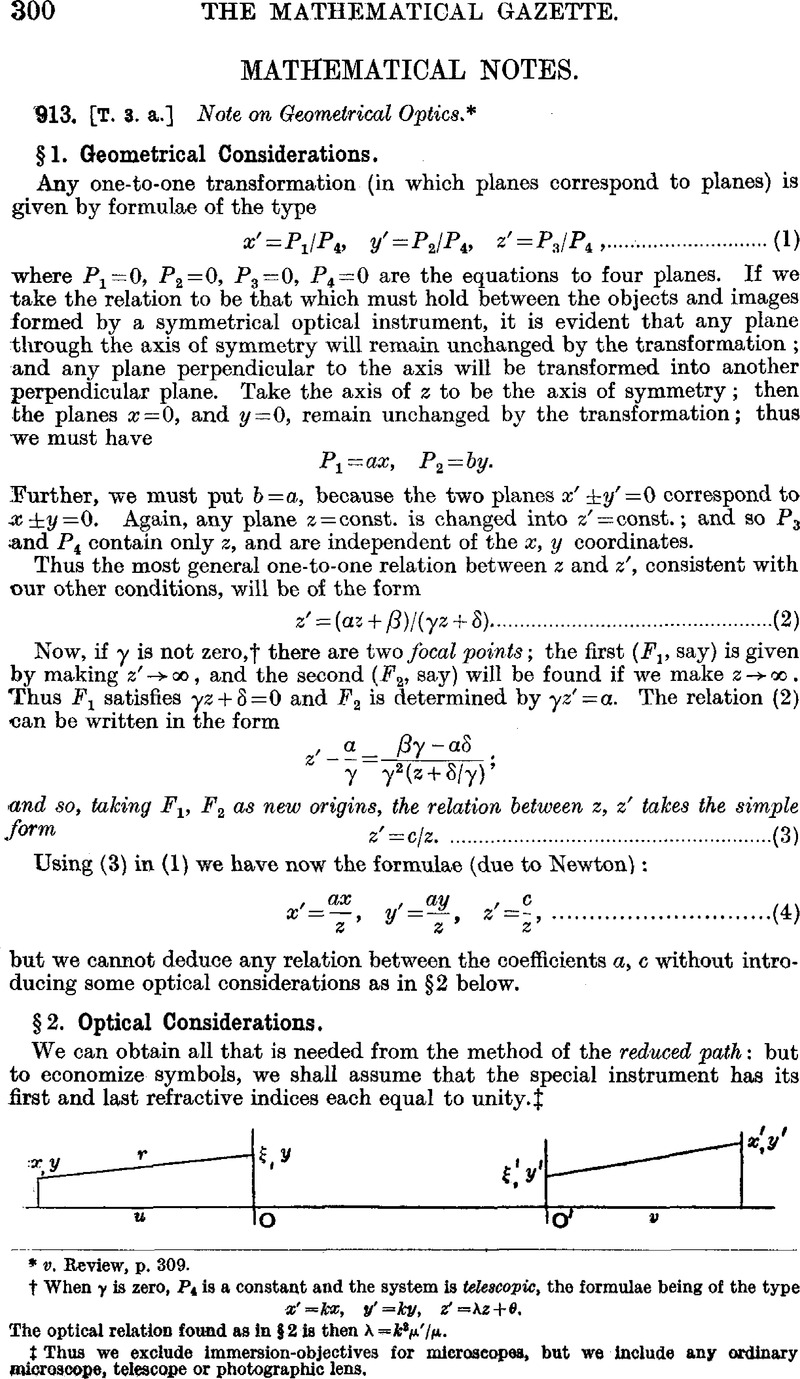No CrossRef data available.
Article contents
913. [T. 3. a.] Note on Geometrical Optics*
Published online by Cambridge University Press: 03 November 2016
Abstract

- Type
- Mathematical Notes
- Information
- Copyright
- Copyright © Mathematical Association 1929
Footnotes
v. Review, p. 309.
When γ is zero, P4 is a constant and the system is telescopic, the formulae being of the type

The optical relation found as in § 2 is then 
Thus we exclude immersion-objectives for microscopes, but we include any ordinary microscope, telescope or photographic lens.
For if we restrict our work to rays lying in a plane through the axis, that plane can be taken as the plane of zx; then the incident ray will be such that y =0, m=0, and thus the terms containing y and m will be missing from the formula found for x′.
The “first order aberrations” are derived from the six terms of the second order in Φ; and there are five independent aberrations (see Dr. Steward’s Tract, pp. 30-32).
In fact, if we eliminate the ratio x′: x we find that, for consistency, we must have

and if we multiply the first equation of (13) by (AC—B2), it will be found to agree with the equation just found. When AC=B2, we obtain the telescopic case; this presents no fresh point of difficulty, but details are left to the reader.
In general, the reader will have no difficulty in seeing that c = a2μ′/μ, if the refractive indices are taken as μ, μ′: and that, in the usual phraseology of Optics, this is equivalent to the statement that the two focal lengths are in the same ratio as μ: μ′. In the present case −a is the focal length, as ordinarily defined; while, allowing for μ and μ′, −a is the first focal length and −aμ′ is the second, c being equal to their product.
Thus our problem corresponds to the image of a star in a telescope; or (for ordinary purposes) to the image formed on a plate by a photographic lens.
Review, p. 309.
References
page 300 note * v. Review, p. 309.
page 300 note † When γ is zero, P 4 is a constant and the system is telescopic, the formulae being of the type
![]()
The optical relation found as in § 2 is then ![]()
page 300 note ‡ Thus we exclude immersion-objectives for microscopes, but we include any ordinary microscope, telescope or photographic lens.
page 301 note * For if we restrict our work to rays lying in a plane through the axis, that plane can be taken as the plane of zx; then the incident ray will be such that y =0, m=0, and thus the terms containing y and m will be missing from the formula found for x′.
page 301 note † The “first order aberrations” are derived from the six terms of the second order in Φ; and there are five independent aberrations (see Dr. Steward’s Tract, pp. 30-32).
page 302 note * In fact, if we eliminate the ratio x′: x we find that, for consistency, we must have
![]()
and if we multiply the first equation of (13) by (AC—B 2), it will be found to agree with the equation just found. When AC=B 2, we obtain the telescopic case; this presents no fresh point of difficulty, but details are left to the reader.
page 302 note † In general, the reader will have no difficulty in seeing that c = a2μ′/μ, if the refractive indices are taken as μ, μ′: and that, in the usual phraseology of Optics, this is equivalent to the statement that the two focal lengths are in the same ratio as μ: μ′. In the present case −a is the focal length, as ordinarily defined; while, allowing for μ and μ′, −a is the first focal length and −aμ′ is the second, c being equal to their product.
page 302 note ‡ Thus our problem corresponds to the image of a star in a telescope; or (for ordinary purposes) to the image formed on a plate by a photographic lens.
page 303 note * Review, p. 309.


